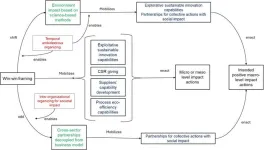(Press-News.org) EPFL researchers have published a programmable framework that overcomes a key computational bottleneck of optics-based artificial intelligence systems. In a series of image classification experiments, they used scattered light from a low-power laser to perform accurate, scalable computations using a fraction of the energy of electronics.
As digital artificial intelligence systems grow in size and impact, so does the energy required to train and deploy them – not to mention the associated carbon emissions. Recent research suggests that if current AI server production continues at its current pace, their annual energy consumption could outstrip that of a small country by 2027. Deep neural networks, inspired by the architecture of the human brain, are especially power-hungry due to the millions or even billions of connections between multiple layers of neuron-like processors.
To counteract this mushrooming energy demand, researchers have doubled down on efforts to implement optical computing systems, which have existed experimentally since the 1980s. These systems rely on photons to process data, and although light can theoretically be used to perform computations much faster and more efficiently than electrons, a key challenge has hindered optical systems’ ability to surpass the electronic state-of-the art.
“In order to classify data in a neural network, each node, or ‘neuron’, must make a ‘decision’ to fire or not based on weighted input data. This decision leads to what is known as a nonlinear transformation of the data, meaning the output is not directly proportional to the input,” says Christophe Moser, head of the Laboratory of Applied Photonics Devices in EPFL’s School of Engineering.
Moser explains that while digital neural networks can easily perform nonlinear transformations with transistors, in optical systems, this step requires very powerful lasers. Moser worked with students Mustafa Yildirim, Niyazi Ulas Dinc, and Ilker Oguz, as well as Optics Laboratory head Demetri Psaltis, to develop an energy-efficient method for performing these nonlinear computations optically. Their new approach involves encoding data, like the pixels of an image, in the spatial modulation of a low-power laser beam. The beam reflects back on itself several times, leading to a nonlinear multiplication of the pixels.
“Our image classification experiments on three different datasets showed that our method is scalable, and up to 1,000 times more power-efficient than state-of-the-art deep digital networks, making it a promising platform for realizing optical neural networks,” says Psaltis.
The research, supported by a Sinergia grant from the Swiss National Science Foundation, has recently been published in Nature Photonics.
A simple structural solution
In nature, photons do not directly interact with each other the way charged electrons do. To achieve nonlinear transformations in optical systems, scientists have therefore had to ‘force’ photons to interact indirectly, for example by using a light intense enough to modify the optical properties of the glass or other material it passes through.
The scientists worked around this need for a high-power laser with an elegantly simple solution: they encoded the pixels of an image spatially on the surface of a low-power laser beam. By performing this encoding twice, via adjustment of the trajectory of the beam in the encoder, the pixels are multiplied by themselves, i.e., squared. Since squaring is a non-linear transformation, this structural modification achieves the non-linearity essential to neural network calculations, at a fraction of the energy cost. This encoding can be carried out two, three or even ten times, increasing the non-linearity of the transformation and the precision of the calculation.
“We estimate that using our system, the energy required to optically compute a multiplication is eight orders of magnitude less than that required for an electronic system,” Psaltis says.
Moser and Psaltis emphasize that the scalability of their low-energy approach is a major advantage, as the ultimate goal would be to use hybrid electronic-optical systems to mitigate the energy consumption of digital neural networks. However, further engineering research is needed to achieve such scale-up. For example, because optical systems use different hardware than electronic systems, a next step that the researchers are already working on is developing a compiler to translate digital data into code that optical systems can use.
END
Engineers bring efficient optical neural networks into focus
EPFL researchers have published a programmable framework that overcomes a key computational bottleneck of optics-based artificial intelligence systems.
2024-08-12
ELSE PRESS RELEASES FROM THIS DATE:
"All of us urgently need to band together to pass a robust and just earth to future generations," says eminent environmental lawyer Edith Brown Weiss
2024-08-12
Amsterdam, August 12, 2024 – An article in a special issue on The Planetary Future published in Environmental Policy and Law (EPL) by IOS Press (now part of Sage), considers the Planetary Trust as an essential framework underlying today’s kaleidoscopic world, reviews important developments in implementing the Trust, and focuses on important steps to take now to ensure a just, robust Earth system for present and future generations.
Bharat H. Desai, PhD, Jawaharlal Nehru University, Centre for International Legal Studies, and Editor-in-Chief ...
Framing sustainability strategies for the enactment of corporate actions with positive macro-level impact: Evidence from a developing country
2024-08-12
Transforming Sustainability Strategies: Ecuadorian Corporations Leading the Way
The Bigger Picture: Shifting from Micro to Macro Impacts
The research redefines sustainability by examining how strategic framing can elevate corporate actions to achieve significant macro-level impacts. Moving beyond individual and community-focused efforts, the study highlights broad-scale changes that enhance societal and environmental well-being, including nationwide poverty reduction, environmental improvements, and public health advancements.
Corporations ...
Comparative safety of in utero exposure to buprenorphine combined with naloxone vs buprenorphine alone
2024-08-12
About The Study: There were similar and, in some instances, more favorable neonatal and maternal outcomes for pregnancies exposed to buprenorphine combined with naloxone compared with buprenorphine alone. For the outcomes assessed, compared with buprenorphine alone, buprenorphine with naloxone during pregnancy appears to be a safe treatment option. This supports the view that both formulations are reasonable options for the treatment of opioid use disorder in pregnancy, affirming flexibility in collaborative treatment decision-making.
Corresponding ...
Pink elephants in the brain?
2024-08-12
Our brain interprets visual information by combining what we see with what we already know. A study published in the journal Neuron by researchers at the Champalimaud Foundation, and supported by the CaixaResearch Health Call of the la Caixa Foundation, reveals a mechanism for learning and storing this existing knowledge about the world. They found that neurons are wired to connect seemingly unrelated concepts. This wiring may be crucial for enhancing the brain’s ability to predict what we see based on past experiences, and bring us a step closer to understanding how this process goes awry ...
Heat caused over 47,000 deaths in Europe in 2023, the second highest burden of the last decade
2024-08-12
More than 47,000 people died in Europe as a result of high temperatures in 2023, the warmest year on record globally and the second warmest in Europe. This is the estimate of a study led by the Barcelona Institute for Global Health (ISGlobal), a centre supported by the "la Caixa" Foundation, and published in Nature Medicine. The researchers report that the vulnerability to heat of European societies has progressively decreased over the present century, and estimate that without these societal adaptation processes, the heat related mortality burden over the past year would have been 80% higher.
The study replicates the methodology used last year in another paper ...
Early-childhood tablet use and outbursts of anger
2024-08-12
About The Study: Child tablet use at age 3.5 years was associated with more expressions of anger and frustration by the age of 4.5 years in this study. Child proneness to anger/frustration at age 4.5 years was then associated with more use of tablets by age 5.5 years. These results suggest that early-childhood tablet use may contribute to a cycle that is deleterious for emotional regulation.
Corresponding Author: To contact the corresponding author, Caroline Fitzpatrick, PhD, email caroline.fitzpatrick@usherbrooke.ca.
To access the embargoed ...
Alcohol consumption patterns and mortality among older adults with health-related or socioeconomic risk factors
2024-08-12
About The Study: In this cohort study of older drinkers from the UK, even low-risk drinking was associated with higher mortality among older adults with health-related or socioeconomic risk factors. The attenuation of mortality observed for wine preference and drinking only during meals requires further investigation, as it may mostly reflect the effect of healthier lifestyles, slower alcohol absorption, or nonalcoholic components of beverages.
Corresponding Author: To contact the corresponding author, Rosario Ortolá, MD, PhD, ...
An appetizer can stimulate immune cells’ appetite, a boon for cancer treatments
2024-08-12
(Santa Barbara, Calif.) — The body has a veritable army constantly on guard to keep us safe from microscopic threats from infections to cancer. Chief among this force is the macrophage, a white blood cell that surveils tissues and consumes pathogens, debris, dead cells, and cancer. Macrophages have a delicate task. It’s crucial that they ignore healthy cells while on patrol, otherwise they could trigger an autoimmune response while performing their duties.
Researchers at UC Santa Barbara sought to understand how these immune cells choose what and when to eat. A paper published ...
New genetically engineered wood can store carbon and reduce emissions
2024-08-12
Researchers at the University of Maryland genetically modified poplar trees to produce high-performance, structural wood without the use of chemicals or energy intensive processing. Made from traditional wood, Engineered wood is often seen as a renewable replacement for traditional building materials like steel, cement, glass and plastic. It also has the potential to store carbon for a longer time than traditional wood because it can resist deterioration, making it useful in efforts to reduce carbon emissions.
But the hurdle to true sustainability in engineered wood is that it requires processing with volatile chemicals and a significant amount of energy, and ...
NK cells expressing interleukin-21 show promising antitumor activity in glioblastoma cells
2024-08-12
Natural killer (NK) cells engineered to express interleukin-21 (IL-21) demonstrated sustained antitumor activity against glioblastoma stem cell-like cells (GSCs) both in vitro and in vivo, according to new research from The University of Texas MD Anderson Cancer Center.
The preclinical findings, published today in Cancer Cell, represent the first evidence that engineering NK cells, a type of innate immune cell, to secrete IL-21 resulted in strong activity against glioblastoma, a cancer type in need of more effective treatment options.
“Our ...
LAST 30 PRESS RELEASES:
Autistic and non-autistic faces may “speak a different language” when expressing emotion
No clear evidence that cannabis-based medicines relieve chronic nerve pain
Pioneering second-order nonlinear vibrational nanoscopy for interfacial molecular systems beyond the diffraction limit
Bottleneck in hydrogen distribution jeopardises billions in clean energy
Lung cancer death rates among women in Europe are finally levelling off
Scientists trace microplastics in fertilizer from fields to the beach
The Lancet Obstetrics, Gynecology, & Women’s Health: Taking paracetamol during pregnancy does not increase risk of autism, ADHD or intellectual disabilities, confirms new gold-standard evidence review
Taking paracetamol during pregnancy does not increase risk of autism, ADHD or intellectual disabilities
Harm reduction vending machines in New York State expand access to overdose treatment and drug test strips, UB studies confirm
University of Phoenix releases white paper on Credit for Prior Learning as a catalyst for internal mobility and retention
Canada losing track of salmon health as climate and industrial threats mount
Molecular sieve-confined Pt-FeOx catalysts achieve highly efficient reversible hydrogen cycle of methylcyclohexane-toluene
Investment in farm productivity tools key to reducing greenhouse gas
New review highlights electrochemical pathways to recover uranium from wastewater and seawater
Hidden pollutants in shale gas development raise environmental concerns, new review finds
Discarded cigarette butts transformed into high performance energy storage materials
Researchers highlight role of alternative RNA splicing in schizophrenia
NTU Singapore scientists find new way to disarm antibiotic-resistant bacteria and restore healing in chronic wounds
Research suggests nationwide racial bias in media reporting on gun violence
Revealing the cell’s nanocourier at work
Health impacts of nursing home staffing
Public views about opioid overdose and people with opioid use disorder
Age-related changes in sperm DNA may play a role in autism risk
Ambitious model fails to explain near-death experiences, experts say
Multifaceted effects of inward foreign direct investment on new venture creation
Exploring mutations that spontaneously switch on a key brain cell receptor
Two-step genome editing enables the creation of full-length humanized mouse models
Pusan National University researchers develop light-activated tissue adhesive patch for rapid, watertight neurosurgical sealing
Study finds so-called super agers tend to have at least two key genetic advantages
Brain stimulation device cleared for ADHD in the US is overall safe but ineffective
[Press-News.org] Engineers bring efficient optical neural networks into focusEPFL researchers have published a programmable framework that overcomes a key computational bottleneck of optics-based artificial intelligence systems.


